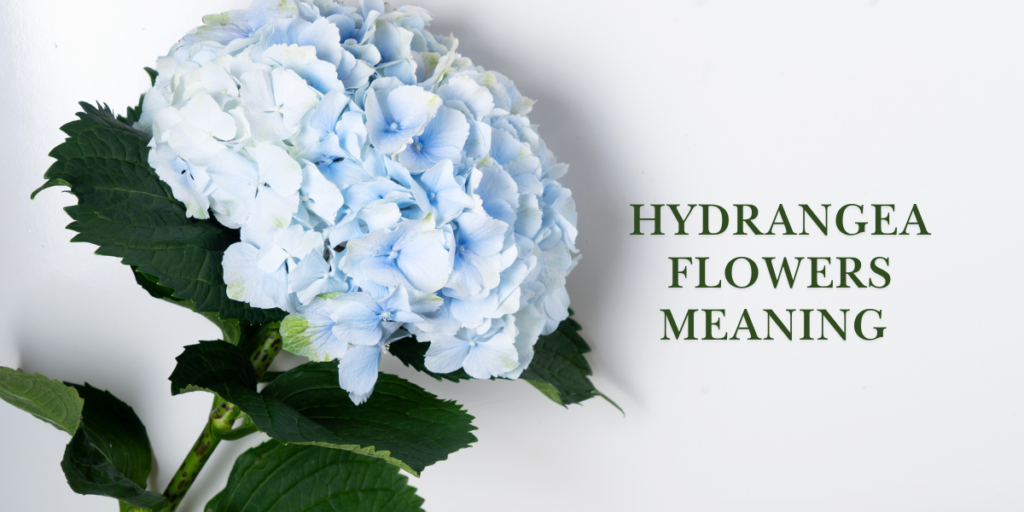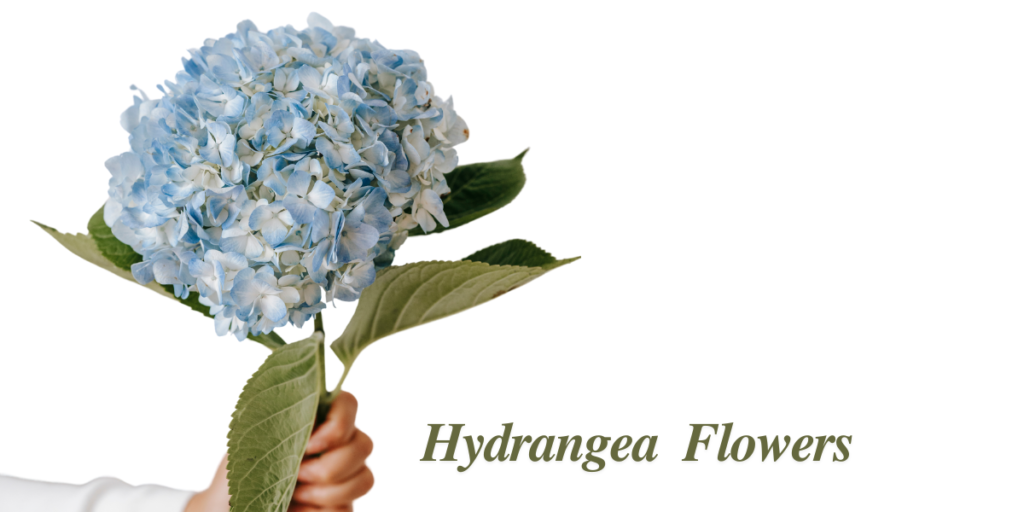Complete Guide to Hydrangea Flowers: Care, Meaning, Drying, and Troubleshooting
Hydrangea flowers are one of the most popular and beloved flowers for home gardens and floral arrangements due to their beautiful, large blooms and range of colors. They are often seen in landscapes, wedding bouquets, and even in dried arrangements. Whether you’re an experienced gardener or just getting started, understanding how to care for hydrangeas, why their colors change, and how to dry or preserve them is essential for maximizing their potential.
This guide will provide you with in-depth information on hydrangea flowers, covering everything from their meaning to how to dry, preserve, and troubleshoot any common issues.
Hydrangea Flowers Meaning and Symbolism

Hydrangea flowers carry different meanings depending on their color, and they are often used to convey emotions or messages in floral arrangements. Here’s an explanation of what each color signifies:
Blue Hydrangea Flowers
Blue hydrangeas symbolize calmness, peace, and understanding. They are often associated with feelings of serenity and are a popular choice for soothing home environments.
Pink Hydrangea Flowers
These represent love, gratitude, and emotional warmth. Pink hydrangeas are a symbol of affection, making them perfect for weddings, anniversaries, or heartfelt gifts.
White Hydrangea Flowers
White hydrangeas are often associated with purity, grace, and new beginnings. They are frequently used in weddings and celebrations, conveying a sense of peace and innocence.
Purple Hydrangea Flowers
Purple hydrangeas symbolize royalty, wealth, and pride. They represent admiration and are ideal for expressing deep respect or admiration toward someone.
Green Flowered Hydrangea
These represent renewal, growth, and harmony. Green hydrangeas are associated with new beginnings and fresh starts, making them a great gift to mark a significant change or milestone.
Understanding these meanings can help you choose the right hydrangea color for any occasion, whether it’s for a floral arrangement, a garden, or a gift.
The Flowering Period of Hydrangeas
Hydrangeas are known for their beautiful blooms, but the time frame during which they flower varies depending on the species. The flowering period of hydrangeas typically starts in late spring and continues through summer into early fall.
Some hydrangea varieties bloom earlier than others:
- Hydrangea macrophylla (Bigleaf Hydrangea) typically blooms from late spring to summer.
- Hydrangea paniculata (Panicle Hydrangea) blooms in late summer and fall, often offering longer-lasting blooms.
The blooming period can also be influenced by environmental factors like temperature, soil conditions, and pruning methods. Proper care, such as ensuring adequate water and sunlight, can help prolong the flowering period of hydrangeas.
Drying Hydrangea Flowers
Hydrangea flowers are prized not only for their vibrant blooms but also for their ability to be dried and preserved. Dried hydrangeas make fantastic additions to home décor, floral arrangements, and wreaths. Here’s a step-by-step guide on how to dry hydrangea flowers:
How to Dry Hydrangea Flowers:
- Choose the Right Time: The best time to cut hydrangeas for drying is when the flowers are fully developed but still firm. You’ll want to pick flowers that are still in their prime, just before they start to fade.
- Cut the Stems: Use sharp pruning shears to cut the flowers just above the first set of leaves.
- Remove Excess Leaves: Trim off any excess leaves from the stems, leaving only the flower heads.
- Air-Dry Method:
- Suspend the flowers upside down in a well-ventilated, dry, and dark location.
- Leave them hanging for about 2-3 weeks, depending on the humidity level and air circulation.
- Avoid hanging them in direct sunlight, as this can cause colors to fade.
- Water-Drying Method:
- Place the stems in a vase with an inch or two of water.
- Allow the water to evaporate completely, leaving the flowers to dry naturally. This method preserves the flowers’ shapes and colors.
Once dried, hydrangeas can be used in various crafts, décor, and arrangements.
Troubleshooting: Hydrangea Not Producing Flowers
A common challenge gardeners encounter with hydrangeas is their failure to produce flowers. If your hydrangea isn’t flowering, several factors could be at play:

Improper Pruning
Cutting hydrangeas back too early in the spring can remove buds that would otherwise bloom later in the season. It’s best to prune only after flowering and to avoid cutting new buds.
Wrong Soil Conditions
Hydrangeas prefer well-drained, slightly acidic soil. If the soil is too alkaline or too acidic, they may not produce blooms.
Lack of Sunlight
Hydrangeas need at least 4-6 hours of sunlight per day. Excessive shade can hinder hydrangeas from flowering effectively.
Late Frosts
Late spring frosts can damage the buds, causing them to fail to bloom.
To help encourage flowering, make sure to prune properly, adjust the soil pH if necessary, and protect your hydrangeas from late frosts.
The Various Colors of Hydrangea Flowers
Hydrangeas are famous for their wide range of colors, each with its own unique charm. Here’s a deeper look at the different types of hydrangea flowers:
| Hydrangea Color | Description | Ideal Conditions |
|---|---|---|
| Blue Hydrangea | Symbolizes calmness and peace. Ranges from pale to deep blue. | Acidic soil with good drainage. |
| Pink Hydrangea | Represents love and affection. Colors range from blush to bold pink. | Slightly alkaline soil. |
| Purple Hydrangea | Represents royalty and respect. Colors range from lavender to deep purple. | Balanced pH soil. |
| Green Hydrangea | Represents renewal and growth. Usually appears late in the season, turning into white or pink. | Slightly acidic to neutral soil. |
| Red Hydrangea | Symbolizes deep emotions and passion. Rare and stunning in red hues. | Slightly alkaline soil. |
| White Hydrangea | Represents purity and grace. Used in weddings and celebrations. | Slightly acidic soil with good sunlight. |
These are the most common hydrangea colors and their respective growing conditions. The color of the blooms can also vary based on pH levels in the soil, which is why hydrangeas are often called “chameleon flowers.”
Artificial Hydrangea Flowers
If you don’t have the time or space to grow real hydrangeas, faux hydrangea flowers are a great option. Available in silk blue hydrangea flowers, white hydrangea fake flowers, and many other varieties, artificial hydrangeas look incredibly realistic and can be used in a variety of settings:
- Wedding Arrangements: Faux hydrangeas, especially white hydrangea wedding flowers, are a great alternative for brides who want the beauty of hydrangeas without worrying about wilting.
- Home Décor: Faux flowers can brighten up a room, add texture to an arrangement, or create stunning centerpieces.
- Long-Term Use: Artificial hydrangeas last much longer than real flowers, and they don’t require care, making them a practical and low-maintenance option.
Preserving and Reviving Hydrangea Flowers
If you have cut hydrangea flowers, it’s important to preserve them properly to extend their life.
How to Revive Hydrangeas:
- Reviving Wilted Hydrangeas: If hydrangea flowers begin to wilt, place the cut stems in a bucket of lukewarm water for 1-2 hours. Hydrangeas can absorb water through their stems, and this will help revive their turgidity.
- Cutting Hydrangea Flowers for Vases: Always cut the stems at an angle with sharp shears, and place them in water immediately. You can also add a little sugar or floral preservative to the water to keep the flowers fresh for longer.
Flowers Similar to Hydrangeas
There are many other flowers that resemble hydrangeas or share a similar aesthetic:
- Viburnum Snowball: This flower has similar round, clustered blooms.
- Lilacs: Lilacs have a similar shape and texture but offer a fragrant, smaller bloom.
- Peonies: Known for their large, showy flowers, peonies share a similar lush, full-bodied bloom as hydrangeas.
Conclusion
Hydrangeas are a diverse, beautiful, and symbolic flower, offering everything from vibrant color variations to long-lasting dried arrangements. By understanding their care, troubleshooting common issues, and using them in different settings, you can maximize their beauty and impact in your garden or home décor. Whether you’re new to hydrangeas or a seasoned expert, this guide will help you appreciate and grow these stunning flowers to their fullest potential.
General Questions
- What is the most common type of hydrangea?
The most common type of hydrangea is the Bigleaf Hydrangea (Hydrangea macrophylla), which includes varieties like mophead and lacecap hydrangeas. - Are hydrangea flowers toxic to pets?
Yes, hydrangeas are mildly toxic to pets, especially dogs and cats. Ingesting parts of the plant can cause gastrointestinal upset and vomiting. - How often should I water my hydrangeas?
Hydrangeas prefer consistently moist soil. Water them consistently, particularly during dry spells, while ensuring the soil has proper drainage to avoid root rot.
Care and Maintenance
- What kind of sunlight do hydrangeas need?
Hydrangeas flourish in partial shade but can also withstand full sun in cooler climates. Too much direct sunlight can cause the leaves to burn, especially for varieties like blue hydrangeas. - Can I grow hydrangeas in a pot?
Yes, hydrangeas can be grown in pots. Ensure the pot has good drainage, and choose a variety that is suited for container growth, such as Hydrangea paniculata. - Why are my hydrangea flowers turning brown?
Brown hydrangea blooms are typically a result of environmental stress, such as too much sun, dehydration, or aging. Check the plant’s water needs and sun exposure.
Hydrangea Flowering and Growth
- When do hydrangeas bloom?
Hydrangeas typically bloom in late spring to summer, with some varieties like Hydrangea paniculata continuing into fall. The specific timing varies based on the variety and climate. - Why isn’t my hydrangea producing flowers?
If your hydrangea isn’t flowering, it could be due to improper pruning, a lack of sunlight, poor soil conditions, or late frost damage that affected the buds. - How do I prune my hydrangeas to encourage more blooms?
Prune hydrangeas after they’ve bloomed, cutting back the old flowers and any dead or damaged stems. For some types, like the Bigleaf Hydrangea, avoid heavy pruning in early spring.
Hydrangea Drying and Preservation
- How do I dry hydrangea flowers?
You can dry hydrangea flowers by hanging them upside down in a cool, dry place or by placing them in a vase with water until the water evaporates. - Can I preserve hydrangea flowers?
Yes, hydrangeas can be preserved by drying them or using a flower preservative solution. They can also be dipped in wax for a long-lasting preserved look. - How do I revive wilting hydrangea flowers?
To revive wilting hydrangea flowers, place the stems in lukewarm water for a couple of hours. This allows the stems to rehydrate and the flowers to regain their structure.
Hydrangea Flowers for Décor and Use
- Can I use artificial hydrangeas for my wedding?
Yes, faux hydrangeas like white hydrangea wedding flowers are a great alternative for weddings, especially if you want long-lasting arrangements that won’t wilt. - What are some flowers similar to hydrangeas?
Flowers like peonies, viburnum, and mock orange resemble hydrangeas in appearance, offering large, clustered blooms with a similar aesthetic. - Can I use dried hydrangeas for décor?
Yes, dried hydrangeas are popular in home décor and crafts, making beautiful wreaths, bouquets, and centerpieces. They can also be used in holiday arrangements.
Troubleshooting Hydrangeas
How can I prevent deer from eating my hydrangeas?
Deer are attracted to hydrangeas, but you can prevent damage by using deer repellents, fencing, or planting hydrangeas in an area that is difficult for deer to access..
Why are my hydrangea flowers turning green?
Hydrangeas naturally change color based on soil pH, but flowers may turn green as they age. Additionally, some hydrangea varieties, like the green flowered hydrangea, naturally start as green before transitioning to white or pink.
What should I do if my hydrangea flowers turn brown and wilt?
Brown, wilted hydrangea flowers are often caused by environmental stress, including extreme temperatures or underwatering. Ensure regular watering and avoid too much direct sunlight.












Post Comment